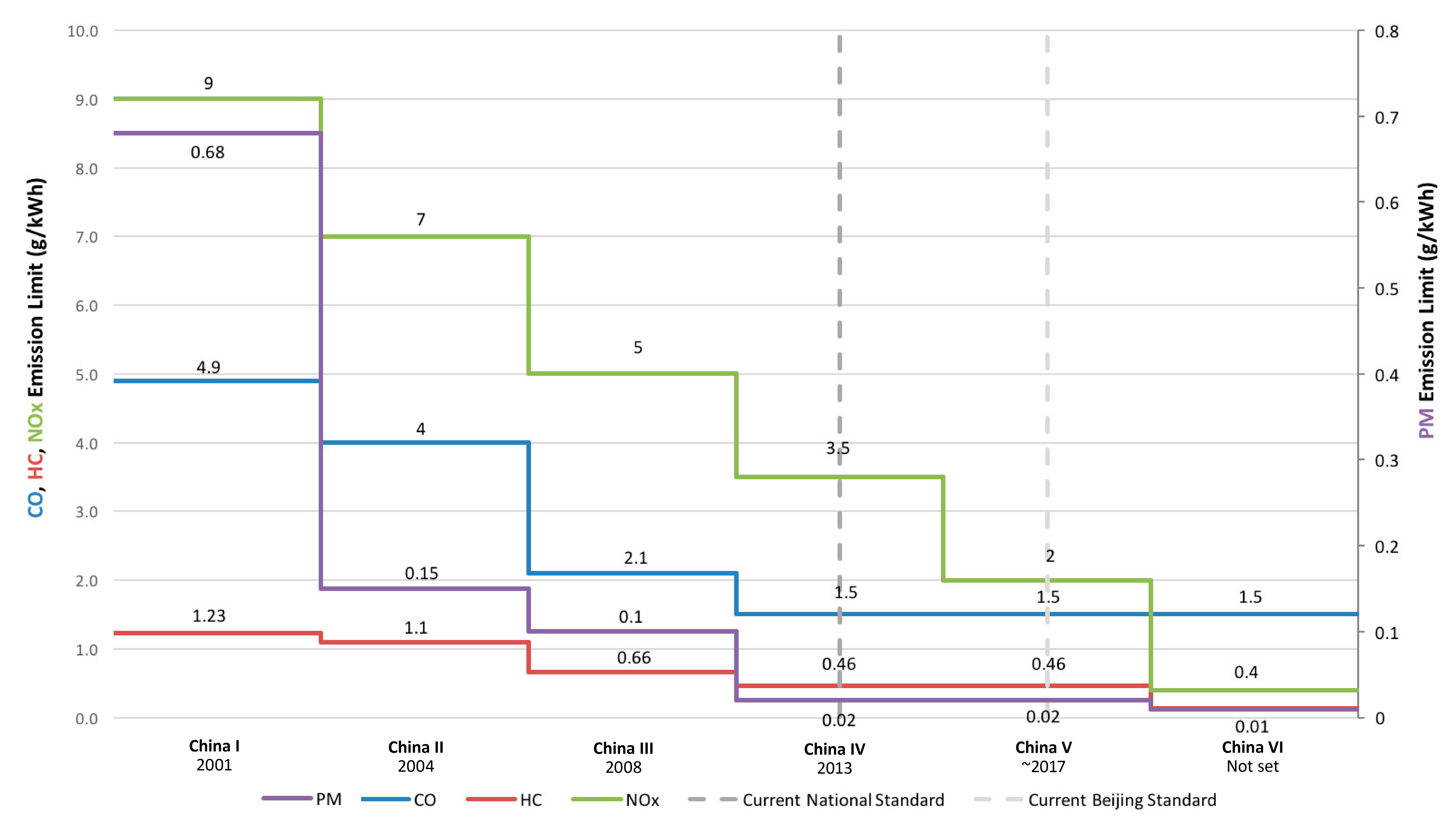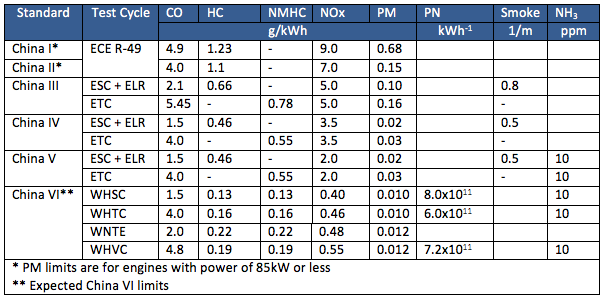China Diesel Emission Standards
Here’s an excerpt from the report I’m producing with Asia Society in San Francisco. There previously had never been a complete visualization of all of China’s diesel engine emission standards, so I punched DieselNet and China Ministry of Environmental Protection data into Excel and voila! Special thanks to Cristin Lim for helping me with the graph design.
Diesel vehicles are one of the most significant sources of air pollution in China, contributing a large share of PM2.5 and NOx emissions that can lead to high ozone episodes. Types of diesel vehicles are heavy-duty freight trucks, city transit buses, coaches, light-duty passenger vehicles, rural vehicles, off-road construction vehicles, port haulers, and marine ocean-going vessels. Diesel vehicles are especially numerous and significant sources of air pollution in major cities such as Beijing, Shanghai, and the Pearl River Delta.(1) The Ministry of Environmental Protection’s 2015 Annual Report of Vehicle Exhaust Emission Control states that diesel vehicles are the source of nearly 70% of the total NOx emissions from vehicle exhaust and more than 90% of the PM.(2) Overall, vehicles are estimated to contribute a third of total NOx pollution and between a quarter and third of PM pollution in the country.(3) The total number of diesel trucks in China has leapt from 9 million in 2000 to almost 33 million in 2013, indicating the rapid growth of this pollution source.(4)
Emissions standards are the most important policy in place to address pollution from new diesel engines and meet national pollutant reduction targets. China’s emission standards began implementation as China I in 2001 and have been ratcheted in subsequent China II (2004), China III (2008), and China IV (2013) standards.(5) These standards have forced the adoption of emissions control technologies for new trucks and buses, such as diesel oxidative catalysts and exhaust gas recirculation. The real world emission factors of diesel trucks and buses in China were reduced significantly from pre-China I to China III for all pollutants except NOx.

Sub-national regions and cities in China are permitted to implement its own vehicle emission standards in advance of the nationwide implementation dates, pending State Council approval. Beijing has historically led in the advanced implementation of vehicle emission standards, followed by Shanghai, Guangzhou, and some other major cities. China V has been in effect in Beijing since June 2015 and currently only applies to public buses and municipal service vehicles in Shanghai and Guangzhou.(6) Beijing Environmental Protection Bureau’s proposed China VI, the strictest emissions standards for heavy-duty vehicles thus far, are set to go into effect December 2017.
The quality of diesel fuel, particularly the sulfur concentration, is a concern which affects emissions control capability. Nationwide, China IV standards of 2013 were delayed in China for two and a half years due to fuel quality problems. Certain emissions control technologies like selective catalytic reduction require low-sulfur fuel to operate properly. However, many of the fuel refineries in China still produce fuel with insufficiently high levels of sulfur. Nationwide China V implementation, originally scheduled for 2012/2013, has also been delayed until December 2017. The stated reason for the delays was the inadequate nationwide supply of high quality fuel. For over a decade, China’s regulators and oil companies could not agree upon a suitable timeline for increasing nationwide low-sulfur fuel supply.(7) The heavy air pollution episodes of the winter of 2013 finally catalyzed high-level government intervention. Subsequent fuel quality standards are aligned with emissions standards to bring fuel quality standards to world-class 10ppm sulfur levels by December 2017.

For off-road machinery like construction vehicles, agricultural vehicles, and port haulers, China again adopts standards based on European regulations. The current standards, Stage III, are based on EU Stage IIIA and have been effective since October 2014.(8) The effective date for Stage IV standards has not yet been set. Emission limits for the smallest engines (50 hp) are consistent with US Tier 1/2 standards. In 2014 Off-road vehicles and equipment are estimated by the Vehicle Emission Control Center of the Ministry of Environmental Protection to be responsible for 30.9 percent of the NOx and 26.0 percent of the PM emissions of total mobile emission sources (including ocean vessels and on-road sources).(9)
Sources:
- Huo, H. (2012). On-board measurements of emissions from diesel trucks in five cities in China. Atmospheric Environment, 54, 159-167.
- Ministry of Environmental Protection of China. (2015). 2015 Annual Report on Vehicle Exhaust Emission Control. Beijing: Ministry of Environmental Protection of China.
- International Council on Clean Transportation. (2015). Costs and Benefits of Motor Vehicle Emission Control Programs in China. Washington DC: ICCT.
- National Bureau of Statistics of China. (2014). Annual Data. Retrieved May 11, 2016, from National Data: http://data.stats.gov.cn/english/easyquery.htm?cn=C01
- Miller, J. (2016, February 23). China: Heavy-duty: Emissions. Retrieved May 9, 2016, from Transportpolicy.net: http://transportpolicy.net/index.php?title=China:_Heavy-duty:_Emissions
- ECOpoint Inc. (2015, December). Emission Standards: China: Heavy-duty Truck and Bus Engines. Retrieved April 27, 2016, from DieselNet: https://www.dieselnet.com/standards/cn/hd.php
- International Council on Clean Transportation. (2013, March). China announces breakthrough timeline for implementation of ultra-low sulfur fuel standards. Retrieved from ICCT: http://www.theicct.org/sites/default/files/publications/ICCTupdate_CH_fuelsulfur_mar2013_rev.pdf
- ECOpoint Inc. (2014, June). Emission Standards: China: Nonroad Engines. Retrieved April 18, 2016, from DieselNet: https://www.dieselnet.com/standards/cn/nonroad.php
- Ding, Y. (2014, September 19). Challenges and Countermeasures of Mobile Source Pollution Control in China. Retrieved May 18, 2016, from Energy Foundation China: http://www.efchina.org/Attachments/Foundation-News/news-efchina-20140918/4-15.DING%20Yan_EN.pdf
Table and graph sources:
- Ministry of Environmental Protection of China. (2001, April 16). Limits and measurement methods for exhaust pollutants from compression ignition engines of vehicles. Retrieved May 26, 2016, from Ministry of Environmetal Protection of China website: http://www.mep.gov.cn/image20010518/1923.pdf
- DieselNet. (2015, December). Heavy-Duty Truck and Bus Engines. Retrieved May 9, 2016, from DiselNet: https://www.dieselnet.com/standards/cn/hd.php
